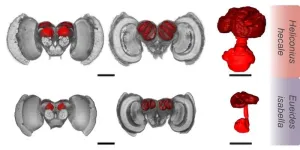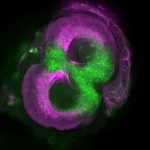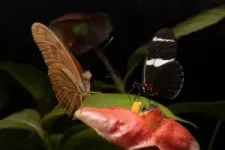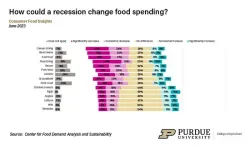(Press-News.org) Heliconius butterflies’ brains grew as they adopted a novel foraging behaviour, scientists at the University of Bristol have found.
A region of their brain, known as the mushroom body due to its shape, are two to four times larger than those of their close relatives.
The findings, published today in Nature Communications, suggest that the structure and function of the nervous system are closely linked to an organism's ecological niche and behaviour.
Dr Stephen Montgomery of Bristol’s School of Biological Sciences explained: “Heliconius are the only butterflies known to collect and digest pollen, which gives them an adult source of protein, when most other butterflies exclusively obtain protein as caterpillars.
“This shift in diet allows Heliconius to live much longer lives, but they seemingly only collect pollen from specific plant species that occur at low densities.
“Learning the location of these plants is therefore a critical behaviour for them, but to do so they must presumably invest more in the neural structures and cells that support spatial memory.”
The team focused on the relationship between mushroom body expansion, sensory specialization and the evolutionary innovation of pollen feeding.
The study involved a unique synthesis of comparative data on large-scale brain structure, cellular composition and connectivity in the brain, and studies of behaviour across species.
They built 3D models of the brain in 30 pollen-feeding species of Heliconius, and 11 species from closely related genera, collected from across Central and South America.
The volume of different brain areas was measured and mapped over phylogenetic (family) trees to estimate where major evolutionary changes in brain composition occurred.
They then investigated changes in neural circuitry by quantifying in the number of neurons in the mushroom bodies and the density of their connections, as well as sensory specialisation by tracing neural inputs from brain areas that process visual information and smell before sending it to the central brain.
Finally, in partnership with the Smithsonian Tropical Research Institute in Panama, they conducted behavioural experiments in key species to assess whether the observed expansion of the mushroom body correlated with improved visual learning and memory.
One striking result is the remarkable range of variation in mushroom body size observed among these closely-related species within a relatively short evolutionary timeframe. Across the whole dataset mushroom body size varies by 25-fold.
This provides a compelling example of how specific brain structures can vary independently over evolutionary time, known as mosaic evolution, when under strong selective constraints for behavioural adaptation.
Dr Montgomery added: “We identified that changes in mushroom body size are due to an increased number of ‘Kenyon cells’, the neurons that form the majority of the mushroom body and whose interactions are thought to be the basis of memory storage, as well as increased inputs from the visual system.
“This expansion and visual specialization of the mushroom bodies were accompanied by enhanced visual learning and memory abilities. Through this synthesis of data types, we provide a clear example of a novel foraging behaviour coinciding with adaptations in the brain and associated cognitive shifts.”
Co-lead author, Bristol’s Dr Antoine Couto, said: “"The study reveals how brain structure of Heliconius butterflies, specifically the mushroom bodies, has undergone remarkable changes that are tightly linked to their specialized foraging behaviours.
“These butterflies have evolved larger mushroom bodies with enhanced visual processing abilities, allowing them to discriminate complex visual patterns and retain visual memories over extended periods. These findings highlight the fascinating connection between brain evolution and behavioural adaptations in the natural world."
Dr Fletcher Young, also co-lead author, added: “This study provides a rare combination of neurobiological and behavioural data across closely related species, revealing a clear example of marked evolutionary changes in the brain over a relatively short time scale coinciding with improved visual learning and memory abilities. Identifying such relationships between brain adaptations and behavioural shifts are crucial to our understanding of cognitive evolution.”
Dr Montgomery concluded ““We provide evidence that brain structure can vary in striking ways between even closely related species that live in the same habitats.
“In this example, the innovation of one suite of behaviours has led to a dramatic expansion of critical learning and memory centres in the brain, and we show these neural changes co-occur with substantial enhancements in cognitive ability.
“We hypothesise that these behavioural differences reflect either a direct response to selection on foraging behaviour, and the information the butterflies are extracting for the environment around them to guide their behaviour”
Understanding the relationship between brain anatomy, sensory processing, and foraging behaviour in Heliconius butterflies could also provide insights into the evolution of learning and memory mechanisms in not only insects, but other animals as the function and circuitry of mushroom bodies share some similarities with vertebrate brains. Hence these butterflies provide an excellent system in which to explore the neural basis of learning and memory with widespread relevance.
Paper:
‘Rapid expansion and visual specialisation of learning and memory centers in the brains of Heliconiini butterflies’ in by Stephen Montgomery et al in Nature Communications.
END
Butterfly species’ big brains adapted giving them a survival edge, study finds
2023-07-13
ELSE PRESS RELEASES FROM THIS DATE:
Combination cancer therapies can shrink tumors and improve survival outcomes for patients with advanced non-small lung cancer
2023-07-13
New Haven, Conn. — While pembrolizumab is an approved treatment for patients with stage III non-small cell lung cancer (NSCLC), only some patients respond to this therapy. Treatment failure, researchers say, is often caused by differences in the tumor microenvironment. An ongoing phase II study (KEYNOTE-495/KeyImPaCT) led by a researcher at Yale Cancer Center reveals that combining pembrolizumab with other treatments reduced the size of target tumors, resulting in a higher response rate for patients with advanced NSCLC.
The new research was published July 10 in Nature Medicine.
“We are excited to share these new ...
NSF CAREER award invests in the future of stable computing
2023-07-12
Every night, uncounted numbers of devices across the globe update their operating systems (OS), and everyday users log on expecting fast, secure connections and services to keep their increasingly online lives moving forward. But as artificial intelligence and other more complex systems come online, the foundation of all them is teetering.
Every aspect of society — from government and industry to education and entertainment — relies on devices with stable operating systems. And every OS relies on ...
Collaborative seed grants nurture high-impact social and environmental research
2023-07-12
The National Science Foundation, the National Institutes of Health, and the National Aeronautics and Space Administration have collectively awarded millions of dollars in grant funding to numerous Virginia Tech researchers who all have one thing in common.
They were awarded Emerging Social Aspects of Global Change seed funding.
Since 2015, this funding has led to faculty from seven colleges and 15 departments collaborating and engaging in 10 research projects that address the social or policy aspects of major global environmental issues.
Sponsored by Fralin Life Sciences Institute’s Global Change Center and the Institute ...
The picture of health: Virginia Tech researchers enhance bioimaging and sensing with quantum photonics
2023-07-12
Imagine you just swallowed a pill containing a miniature camera that will help your doctor collect images to diagnose a condition you’ve been battling for years. No, it’s not something from the latest science fiction or Marvel Comics movie – it’s a technique called bioimaging.
While traditional methods of bioimaging such as an MRI, CT scan, or an X-ray are more commonly known, the use of nanodevices is becoming more popular. They are less invasive and provide health care professionals with a closer look deep inside tissue.
Researchers from Virginia Tech’s College of Engineering and College of Science are using their expertise ...
Virginia Tech awarded $3.4 million grant to study the environmental effects of utility-scale solar installations
2023-07-12
As utility-scale solar farms become more widespread as a source of renewable energy, Virginia Tech scientists are researching environmental consequences with respect to stormwater and the sediment and nutrients transported in runoff.
With a $3.4 million grant from the Virginia Department of Environmental Quality, researchers from the College of Agriculture and Life Sciences will lead a comprehensive six-year study to determine how utility-scale solar farms impact stormwater runoff and local soil and water quality throughout the state.
“Solar is probably going to be the No. 1 land use change that will occur over the next decade in many parts of Virginia, particularly in existing ...
Rare brain tumor responds to targeted tumor treatment with ‘unprecedented’ success
2023-07-12
Papillary craniopharyngiomas (PCPs) are a rare type of brain tumor that cause substantial morbidity for patients. While surgery and radiation are often used to treat PCPs, incomplete removal of the tumor and toxicity from radiation can leave patients with life-long health challenges after treatment, including neuroendocrine dysfunction or vision or memory loss. Investigators from the Mass General Cancer Center, a member of the Mass General Brigham healthcare system, led the first multicenter treatment protocol in this rare tumor. The study was based on laboratory discoveries by Mass General Brigham researchers who studied the genetic drivers of PCP growth, ...
Salinity changes threatening marine ecosystems, new UNF study shows
2023-07-12
A groundbreaking study published today reveals the critical yet severely understudied factor of salinity changes in ocean and coastlines caused by climate change. The study was co-authored by an international team of researchers, including Dr. Cliff Ross, University of North Florida biology chair/professor, and Dr. Stacey Trevathan-Tackett, UNF biology graduate program alum and research faculty member at Deakin University in Australia.
Changes in salinity, or salt content, due to climate change and land use can have potentially devastating impacts on vital coastal and estuarine ecosystems, yet this has rarely been studied until now. This new research provides valuable ...
Two UTA professors selected as Fulbright scholars
2023-07-12
Two University of Texas at Arlington faculty members have received Fulbright U.S. Scholar Program awards from the U.S. Department of State and the Fulbright Foreign Scholarship Board.
Kevin Schug, Shimadzu Distinguished Professor of Analytical Chemistry in the Department of Chemistry and Biochemistry, will travel to Palacky University in Olomouc, Czech Republic, continuing a decades-long relationship that began during his days as a graduate student.
Ling Xu, associate professor in the School of Social Work, will use the award to travel to Taiwan and embark on 10-month project to raise awareness about the ...
Daughters breastfed longer, and women accumulated greater wealth in ancient California matriarchal society
2023-07-12
In a new study, researchers and members of the Muwekma Ohlone Tribe of the San Francisco Bay Area are the first to publish evidence of wealth-driven patterns in maternal investment among ancient populations.
Ancestors of the Muwekma Ohlone living 2,000 years ago at Kalawwasa Rummeytak in present-day Silicon Valley in California’s San Francisco Bay Area, placed high value on women’s economic contributions to their communities, according to the study. Women stayed in the villages in which they were born, and their male partners moved from their birth communities to join their wives’ families. Women’s intimate knowledge of the local ecology and female ...
Food insecurity rate hits 17% for the second time in 18 months
2023-07-12
Food insecurity rate hits 17% for the second time in 18 months
WEST LAFAYETTE, Ind. – Reported food insecurity has reached 17%, matching the rate last reached in March 2022, according to the June Consumer Food Insights Report. The new report also includes consumer changes in food spending as a result of a hypothetical recession and sentiments on artificial intelligence.
The survey-based report out of Purdue University’s Center for Food Demand Analysis and Sustainabilityassesses food spending, consumer satisfaction ...









